 Eastern Mojave Vegetation
Eastern Mojave Vegetation
Tom Schweich
 Eastern Mojave Vegetation
Eastern Mojave Vegetation
| A Bibliography on Great Basin Blue Sage (Salvia dorrii) |
|
Tom Schweich |

Topics in this Article: Introduction Literature Review Field Work and Methods Results Taxonomy, Distribution and Growth Habits Anatomy and Physiology Relationships to Soils and Other Plants Life History Succession Insects, Diseases, and Other Pests Discussion Summary Literature Cited |
(No Preface) | |
|
Literature Cited:
Species Lists: Salvia dorrii |
Introduction | |
 Salvia dorrii flower. Salvia dorrii flower.
Species Lists: Salvia dorrii |
||
|
|
Literature Review | |
|
|
Field Work and Methods | |
|
Other articles:
|
||
|
Other articles:
|
||
|
|
Results | |
|
|
White 5 | |
 Volume containing live leaves. Volume containing live leaves.
|
White 5 is one plant that has maintained a nearly constant size since the plot was established. | |
 Salvia dorriiWhite 5 on May 28, 2005. Salvia dorriiWhite 5 on May 28, 2005.
|
||
|
|
White 9 | |
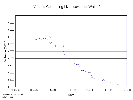 Volume containing live leaves. Volume containing live leaves.
|
||
|
|
White 23 | |
 White 23 in April, 2004 White 23 in April, 2004
|
||
 Salvia dorriiWhite 23 on May 28, 2005. Salvia dorriiWhite 23 on May 28, 2005.
|
Fairly sparse growth, few flowers. | |
|
|
White 24 | |
|
|
White 30 | |
 White 30 in April 1998 White 30 in April 1998
|
||
|
|
White 33 | |
 White 33 in May 2003 White 33 in May 2003
|
White 33 in May 2003. Hopefully this plant is just dormant, rather than dead. However, notice all the little wildflowers around the Salvia dorrii. | |
 White 33 on April 21, 2004 White 33 on April 21, 2004
|
||
|
|
White 37 | |
|
|
White 38 | |
 Salvia dorriiWhite 38 on May 28, 2005. Salvia dorriiWhite 38 on May 28, 2005.
|
The stem of White 38 is split. Last year there were only a few interior leaves on the interior of the split on the north side. This year there is significant growth and good flowers on the north side. | |
|
|
White 40 | |
 White 40 in April 1998 White 40 in April 1998
|
||
|
|
White 41 | |
|
|
White 48 | |
 Salvia dorrii White 48 on May 28, 2005. Salvia dorrii White 48 on May 28, 2005.
|
||
|
|
White 49 | |
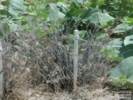 Salvia dorrii White 49 on May 28, 2005. Salvia dorrii White 49 on May 28, 2005.
|
There is just one stem growing with leaves. It can be seen at back left. | |
|
|
White 59 | |
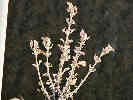 White 59 in August 2002 White 59 in August 2002
|
White 59 on August 31, 2002. | |
 White 59 in May 2003 White 59 in May 2003
|
White 59 in May, 2003. The few leaves that remain are completely dried up. | |
 White 59 on April 21, 2004 White 59 on April 21, 2004
|
White 59 on April 21, 2004. | |
|
|
White 136 | |
 May 25, 2003 May 25, 2003
|
White 36, on May 26, 2003. This was one of the few Salvia dorrii that had current year leaves. | |
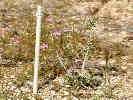 White 36 on April 21, 2004 White 36 on April 21, 2004
|
White 36 on April 21, 2004. | |
|
Other articles:
|
White 136 on May 28, 2005, the date that I renumbered White 36 to White 136. | |
|
|
White 159 | |
 White 159 on May 28, 2005 White 159 on May 28, 2005
|
White 159 on May 28, 2005. | |
|
|
Yellow 13 | |
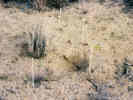 Yellow 13 in August 2002 Yellow 13 in August 2002
|
The "Mirmul hole" in August 2002. No sign of the Mirabilis multiflora. | |
 Yellow 13 in May 2003 Yellow 13 in May 2003
|
Yellow 13 in May 2003, with a Mirabilis multiflora growing behind it. | |
 Yellow 13 on April 21, 2004. Yellow 13 on April 21, 2004.
|
||
 Mirabilis multiflora in my Salvia dorrii plot. Mirabilis multiflora in my Salvia dorrii plot.
|
||
|
|
Yellow 27 | |
 Yellow 27 on May 28, 2005. Yellow 27 on May 28, 2005.
|
Yellow 27 on May 28, 2005. | |
|
|
Yellow 28 | |
 S. dorrii growing shade of Opuntia acanthocarpa. S. dorrii growing shade of Opuntia acanthocarpa.
|
April 1998 | |
 Yellow 28 in April 2001. Yellow 28 in April 2001.
|
April 2001 | |
 Yellow 28 in August 2002 Yellow 28 in August 2002
|
August 2002 | |
 Volume containing live leaves. Volume containing live leaves.
|
May 2003: Yellow 28 first attracted my attention because it is shaded by an Opuntia acanthocarpa. It reached it's maximum size in the El Niņo year of 1998. Since then its leaves have been smaller, and now it competes with three Eriogonum fasciculatum. | |
|
|
Yellow 31 | |
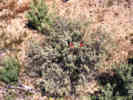 Yellow 31 in April 1998 Yellow 31 in April 1998
|
In April 1998, this plant had 3 stems of Castilleja growing in the interior. In the photo you can also see last year's seed pods at the right. | |
 Yellow 31 on April 21, 2004 Yellow 31 on April 21, 2004
|
Yellow 31 on April 21, 2004 | |
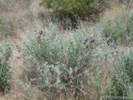 Yellow 31 on May 28, 2005 Yellow 31 on May 28, 2005
|
||
|
|
Yellow 34 | |
 Yellow 34 on April 21, 2004 Yellow 34 on April 21, 2004
|
||
|
|
Yellow 35 | |
 Yellow 35 on April 21, 2004 Yellow 35 on April 21, 2004
|
Yellow 35 on April 21, 2004. | |
 Yellow 35 on May 28, 2005. Yellow 35 on May 28, 2005.
|
Yellow 35 on May 28, 2005 | |
|
|
Yellow 40 | |
 Yellow 40 on April 21, 2004 Yellow 40 on April 21, 2004
|
||
 Yellow 40 on May 28, 2005 Yellow 40 on May 28, 2005
|
Yellow 40 on May 28, 2005 | |
|
|
Yellow 80 | |
|
|
Yellow 83 | |
 Yellow 83 in August 2002 Yellow 83 in August 2002
|
||
|
|
Yellow 90 | |
 Yellow 90 in April 1998 Yellow 90 in April 1998
|
||
|
|
Taxonomy, Distribution and Growth Habits | |
|
|
Taxonomy | |
var. dorrii | ||
|
Other articles:
|
| |
|
Literature Cited:
|
In Utah, the materials are assignable to ssp. dorrii, but some of the plants with nearly glabrous bracts from Washington County approach ssp. argentea (Welshetal1987). | |
|
|
DistributionDetails about the distribution of Salvia dorrii can be found in my page on "Distribution of Salvia dorrii." | |
|
Literature Cited:
Species Lists: Salvia dorrii |
In her Flora of the Northern Mojave Desert, DeDecker (1984) notes that var. dorrii is common and widespread, expecially on non-calcareous soils, up to 10,000 ft. Her 1991 account (DeDecker, 1991) notes that var. dorrii occurs in dry places, mostly on granitic or volcanic rocks, in desert scrub to subalpine zones, 4,000 - 10,500 ft (1,220 - 3,201 m). | |
|
Literature Cited:
|
In Flora of the Northern Mojave Desert, DeDecker (1984) notes that plants in limestone mountains appear to be var. clokey and are found from 4,400 to 9,500 feet elevation. DeDecker's (1991) chapter in Flora of the White-Inyo Range notes that var. clokeyi is found on dry, calcareous slopes and flats, in desert scrub to subalpine zones, 6,000 - 10,000 ft (1,829 - 3049 m). | |
|
Literature Cited:
|
In Utah, the species is found in Creosote bush, Joshua tree, blackbrush, shadscale, sagebrush, mountain brush, and pinyon-juniper communityes at 830-2350 m in Beaver, Iron, Juab, Kane, Millard, Tooele and Washington counties (Welsh, et al. 1987). | |
| A map of the distribution of the species in Utah is available from the Atlas of Vascular Plants of Utah. | ||
|
|
Growth Habits | |
 S. dorrii growing shade of Opuntia acanthocarpa. S. dorrii growing shade of Opuntia acanthocarpa.
|
||
 Salvia dorrii at the 9,000 foot level in the Spring Mountains Salvia dorrii at the 9,000 foot level in the Spring Mountains
|
||
|
Literature Cited:
Other articles:
Species Lists: Salvia dorrii |
Comstock, Cooper and Ehleringer (1988) studies patterns of canopy development and carbon gain in nineteen warm desert shrub species. They found that Salvia dorrii does not have photosynthetic stems, and placed the species in the group that experiences little leaf die-back during drought. | |
|
|
Anatomy and Physiology | |
|
|
Roots and Other Belowground Parts | |
|
|
Stems | |
|
|
Leaves | |
 Node anatomy of S. dorrii. Node anatomy of S. dorrii.
|
||
|
|
Flowers | |
|
|
Relationships to Soils and Other Plants | |
|
|
Relation to Soils | |
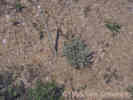 S. dorrii with patches of microphytic soil. S. dorrii with patches of microphytic soil.
|
||
|
|
Plant Associates | |
 S. dorrii with hemiparasite Castilleja (red flowers). S. dorrii with hemiparasite Castilleja (red flowers).
|
||
|
Literature Cited:
Other articles:
Locations: Chicken Water Spring. Mexican Water Spring. |
Cody (1986a) studied shrub spacing patterns at the Granite Mountains and in the Mid Hills. Cody's Mid Hills location is between Mexican Water Spring and Chicken Water Spring. S. dorrii was present only in his Mid Hills quadrats. There, S. dorrii tended toward a "clumped" distribution especially at a higher densities. The species tends to prefer itself, Opuntia ramosissima, and Hymenoclea salsola as neighbors, while avoiding Ericameria [Haplopappus] cooperi. | |
|
Literature Cited:
Species Lists: Salvia dorrii |
Cody (1986b) expands on his previous report, showing root diagrams from his excavation of the roots of several dozens of shrubs. S. dorrii and Ericameria [Haplopappus] cooperi, which seem to avoid each other, both have spreading roots at various intermediate depths. On the other hand, Hymenoclea salsola, with which S. dorrii often associates, is taprooted. | |
|
|
Allelopathy | |
|
|
Competition | |
|
|
Life History | |
|
|
Germination | |
|
|
Seedling Establishment | |
 Nine Salvia dorrii seedlings in my measured plot, Transect 5. Nine Salvia dorrii seedlings in my measured plot, Transect 5.
|
||
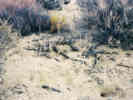 Seedlings in August 2002 Seedlings in August 2002
|
The same area of many seedlings as seen in August, 2002. I don't think (as of May 2003) that any of the seedlings have survived. | |
 Salvia dorrii seedling, Salvia dorrii seedling,
|
||
|
|
Early Growth Stage | |
|
|
Establishment | |
 An older Salvia dorrii in my measured plot, Transect 5. An older Salvia dorrii in my measured plot, Transect 5.
|
||
|
|
Dormancy | |
|
|
Flowering | |
|
|
Seed | |
|
|
Collecting Seed | |
|
|
Vegetation Reproduction | |
|
|
Succession | |
|
|
Grazing Effects | |
|
|
Insects, Diseases, and Other Pests | |
|
Other articles:
Species Lists: Salvia dorrii |
||
|
|
Discussion | |
|
|
Adaptation | |
|
|
The Species In An Ecosystem | |
|
|
Summary | |
|
|
Literature CitedA list of all literature cited by this web site can be found in the Bibliography. | |
| Abrams, LeRoy, and Roxanna S. Ferris. 1944-1951. Illustrated flora of the Pacific states. 4 vols.. Stanford, California.: Stanford University Press.. v. 1. Ophioglossaceae to Aristolochiaceae, ferns to birthworts.--v. 2. Polygonaceae to Krameriaceae, buckwheats to kramerias.--v. 3. Geraniaceae to Scrophulariaceae, geraniums to figworts.--v. 4. Bignoniaceae to Compositae, bignonias to sunflowers | ||
| Bentham, George. 1829. Audibertia. Bot. Reg. 15: 1282. | ||
| Bentham, George. 1831. Audibertia incana. Bot. Reg. 17: 1469. | ||
| Briquet, John Isaac. 1894a. Questions de nomenclature. Bull. Herb. Boissier. 2: 4-88. | ||
| Briquet, John Isaac. 1894b. Rectifications de nomenclature. Bull. Herb. Boissier. 2: 439-440. | ||
| Britton, Nathaniel Lord. 1889. A list of plants collected at Fort Verde and vicinity and in the Mogollon and San Francisco Mountains, Arizona, 1884-1888, by Dr. E. A. Mearns, U. S. A. (with descriptions of new species). Trans. New York Acad. Sci. 8: 61-76. | ||
| Clokey, Ira W. 1951. Flora of the Charleston Mountains, Clark County, Nevada. University of California Press. 24. | ||
| Cody, M. L. 1978. Distribution of Haplopappus and Chrysothamnus in The Mojave Desert. I. Niche position and niche shifts on north-facing granitic slopes. American Journal of Botany. 65(10):1107-1116. | ||
| Cody, M. L. 1986a. Spacing patterns in Mojave Desert plant communities: near-neighbor analysis. Journal of Arid Environments. 11: 199-217. {TAS} | ||
| Cody, M. L. 1986b. Structural niches in plant communities. pp. 381-405 in Diamond, J., and T. J. Case (Eds.). Community Ecology. San Francisco: Harper & Row. {TAS} | ||
| Comstock, J. P., T. A. Cooper, and J. R. Ehleringer. 1988. Seasonal patterns of canopy development and carbon gain in nineteen warm desert shrub species. Oecologia (Berlin). 75(3):327-335. {TAS} [Ecophysiology Lab, Department of Biology, University of Utah, Salt Lake City, UT 84112 USA] | ||
| Cronquist, A. 1959. Labiatae. Univ. Wash. Publ. Biol. 17(4):247-280. | ||
| Curran, M. K. 1885. List of the plants described in California, principally in the Proc. of the Cal. Acad. of Sciences, by Dr. Albert Kellogg, Dr. H. H. Behr, and Mr. H. N. Bolander: with an attempt at their identification. Bull. Calif. Acad. Sci. 1: 128-151. | ||
| DeDecker, Mary. 1984. Flora of the northern Mojave Desert, California. Berkeley, CA: Califonia Native Plant Society.. {TAS} | ||
| DeDecker, Mary. 1991. Shrubs and Flowering Plants. pp. 108-241 in Hall, Clarence A., Jr.. Natural History of the White-Inyo Range, Eastern California. Berkeley, CA: University of California Press, 1991. {TAS} | ||
| Epling, C. C., H. Lewis & P. H. Raven. 1962. Chromosomes of Saliva: section Audibertia. Aliso. 5: 217-221. | ||
| Greene, Edward Lee. 1892. On certain Californian Labiatae. Pittonia. 2: 233-236. | ||
| Hall, H. M. 1902. A botanical survey of San Jacinto Mountain. Univ. Calif. Publ. Bot. 1: 1-140. | ||
| Heller, A. A. 1900. Some changes in nomenclature. Muhlenbergia. 1: 1-8. | ||
| Hickman, James C. (Ed.). 1993. The Jepson manual: higher plants of California. Berkeley, CA: University of California Press.. | ||
| Kellogg, Albert. 1863. Audibertia dorrii - (Kellogg). Proc. Calif. Acad. Nat. Sci. 2: 190. | ||
| Kuntze, O. C. E. 1891. Revisio generum plantarum. 3 volumes. New York: G. E. Schechert. | ||
| Lindley, John. 1831. Audibertia incana. Bot. Reg. 17: 1469. | ||
| Lloyd, Robert M., and Richard S. Mitchell. 1973. A Flora of the White Mountains, California and Nevada. Berkeley, CA: University of California Press. | ||
| MacMahon, James. 1985. Deserts. The Audubon Society nature guides. New York, NY: Alfred A. Knopf. | ||
| Martens, M. & H. Galeotti. 1844. Enumeratio synoptica plantarum phanerogamicaram ab Henrico Galeotti in regionibus mexicanius collectarum. Bull. Acad. Roy. Sci. Bruxelles. 11: 61-79. | ||
| McMinn, Howard E. 1939. An Illustrated Manual of California Shrubs. Berkeley, CA: University of California Press. | ||
| Morefield, James D. 1988. Floristic Habitats of the White Mountains, California and Nevada: A Local Approach to Plant Communities. pp. 1-18 in Hall, Clarence A., Jr and Victoria Doyle-Jones, 1988. The Mary DeDecker Symposium, University of California, White Mountain Research Station.. Plant Biology of Eastern California. | ||
| Morefield, James D., Dean Wm. Taylor, and Mary DeDecker. 1988. Vascular Flora of the White Mountains of California and Nevada: An Updated, Synonymized Working Checklist. pp. 310-364 in Hall, Clarence A., Jr and Victoria Doyle-Jones, 1988. The Mary DeDecker Symposium, University of California, White Mountain Research Station.. Plant Biology of Eastern California. | ||
| Mozingo, Hugh N. 1987. Shrubs of the Great Basin. Reno, NV: University of Nevada Press. | ||
| Munz, P. A. 1927. The southern California species of Salvia (including Ramona). Bull. S. Calif. Acad. Sci. 26: 17-29. | ||
| Munz, P. A. 1935. A manual of southern California botany. Claremont California: Scripps Publishing Fund. | ||
| Reveal, J. L. 1980. Intermountain biogeography--a speculative appraisal. Mentzelia. 4: 1-92. | ||
| Rydberg, Per Axel. 1909. Studies on the Rocky Mountain flora--XX. Bull. Torrey Bot. Club. 36: 675-698. | ||
| Sampson, Arthur W., and Beryl A. Jespersen. 1963. California Range Brushlands and Browse Plants. 1963. {TAS} | ||
| Strachan, Jeffrey L. 1982. A revision of the Salvia dorrii complex (Lamiaceae). Brittonia. 34(2):151-169. | ||
| Strachan, Jeffrey L., and James L. Reveal,. 1981. On the typification of Salvia dorrii (Lamiaceae). Great Basin Naturalist. 41(2):198-200. | ||
| Taylor, Robin M., and Tina J Ayers. 2006. Systematics of Salvia pachyphylla (Lamiaceae). Madroņo. 53(1):11-24. {TAS} | ||
| Twisselmann, E. C. 1967. A flora of Kern County. Wasmann J. Biol. 25: 1-395. | ||
| Welsh, Stanley L., et al. 1987. A Utah Flora. Great Basin Naturalist Memoirs. 9. {TAS} | ||
| Winegar, David. 1982. Desert Wildflowers, Drylands of North America. Beaverton, OR 97075: Beautiful America Publishing Company. {TAS} | ||
Appendix A -- Field Data | ||
| If you have a question or a comment you may write to me at: tomas@schweich.com I sometimes post interesting questions in my FAQ, but I never disclose your full name or address. |
Date and time this article was prepared: 4/21/2025 8:28:51 PM |